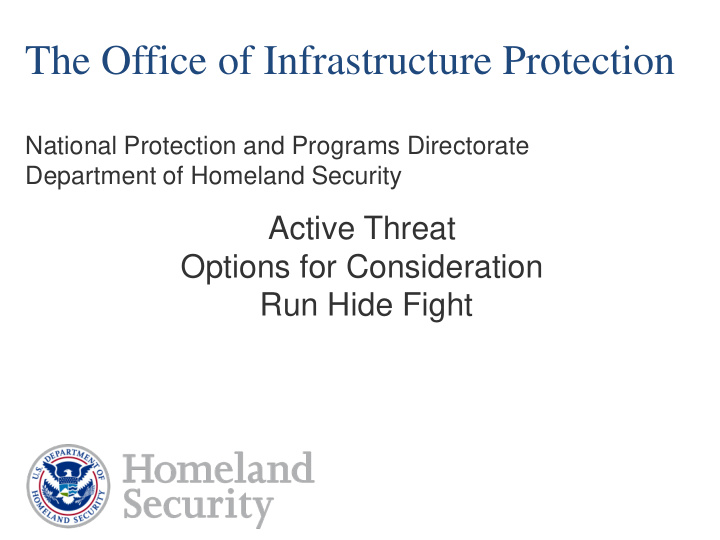



The Office of Infrastructure Protection National Protection and Programs Directorate Department of Homeland Security Active Threat Options for Consideration Run Hide Fight
Today’s Discussion Training vs. Facilitated Discussion Tools for Life Tool Box Active Threat Lockdowns vs. Stay in Place Evolution of police response How to react to an active shooter DHS Resources 2
Active Hazard Natural, Accidental or Intentional which creates an immediate threat or presents an imminent danger 3
DHS Active Threat Individual(s) actively engaged in killing or attempting to kill people in a confined and populated area Vehicle Knife Firearm 4
How to Respond to Hazards Lockdowns Hard - Shelter in Place Soft - Stay in Place 5
6
Active Assailant Situation Overview Active Assailant can attack our workplaces, schools, hospitals, etc. Although many perpetrators have a history of negative — sometimes violent — behavior, there is still no single, accurate one-size-fits-all profile of an active shooter 7
Characteristics of an Active Threat Incident In most cases, there is no pattern or method to the selection of victims Most active shooter situations are unpredictable and evolve quickly Preparedness and awareness are key to helping protect our employees, our customers, and ourselves 8
Active Threat Motivations Terrorism Workplace Violence School Violence Domestic Violence 9
2012 Joint Intelligence Bulletin From investigations and analysis, many active shooters were described as social isolates, harbored feelings of hate and anger Individual has a Grievance – Real or Perceived 10
Active Shooter Incidents August 1, 1966 – Tower of Texas - 17 killed and 32 wounded April 20, 1999 – Columbine, Colorado - 13 Killed and 21 wounded December 2, 2015 – San Bernardino, California 14 killed and 22 wounded June 12, 2016 – Orlando, Florida 49 killed and 53 wounded 11
Vehicle Attacks July 15, 2016 - Nice, France - Truck Attack 84 killed and 300 injured November 28, 2016 - Ohio State University – Vehicle and Knife Attack 11 injured October 31, 2017 - New York City Bike Path – Vehicle Attack 8 killed and 12 injured 17 attacks nationally from 2014-2017 Initial ramming is often followed by a secondary attack Requires minimal planning and coordination 12
Houses of Worship August 5, 2012 - Sikh Temple of Wisconsin, Oak Creek, WI 6 Killed and 4 wounded June 17, 2015 - Emanuel African Methodist Episcopal Church Charleston, South Carolina - 9 killed September 24, 2017 - Burnette Chapel Church of Christ Antioch, Tennessee - 1 killed and 8 wounded November 5, 2017 - First Baptist Church, Sutherland Springs, Texas 26 killed and 20 wounded November 5, 2017 - St. Alphonsus Church, Fresno, California 2 killed October 27 , 2018 – Tree of Life Synagogue, Pittsburgh, PA 11 Killed and 6 wounded 13
Workplace Scenario 14
™ If You See Something Say Something TM used with permission of the NY Transportation Authority.
Lone Wolf 16
The Pathway to Violence Probing & Breaching Pre-Attack Preparation Research & Planning Violent Ideation Grievance
Pathway to Violence Individuals are consumed with a combination of negative emotions and attitudes These can result in observable words or deeds. Depression Anger Powerlessness Superiority Arrogance 18
Behavioral Indicators Talking about previous violent incidents Expressions of suicidal thoughts Unsolicited focus on firearms or other weapons Overreaction to workplace changes Increased use of alcohol or drugs Violations of company policies Expressions of paranoia Angry outbursts Increased absenteeism Exploiting or blaming others Withdrawal
Behavioral Indicators loss of significant relationships changes in financial status feelings of humiliation or rejection on the part of the shooter 20
Options For Considerations: Run Hide Fight 21
Responding to an Active Shooter Situation In an active shooter situation, you should quickly determine the most reasonable way to protect your own life. Run : If there is an accessible escape path, attempt to evacuate the premises Hide : If evacuation is not possible, find a place to hide where the active shooter is less likely to find you Fight : As a last resort, and only when your life is in imminent danger, attempt to disrupt and/or incapacitate the active shooter 22
Active Shooter: What You Can Do An active shooter is an individual actively engaged in killing or attempting to kill people in a confined and other populated area. In most cases, active shooters use firearms and there is no pattern or method to their selection of victims. Active shooter situations are unpredictable and evolve quickly. All employees can help prevent and prepare for potential active shooter situations. This course provides guidance to individuals, including managers and employees, so that they can prepare to respond to an active shooter situation. http://training.fema.gov/EMIWeb/IS/is907.asp 23
Department of Homeland Security Charles M DuShane Protective Security Advisor 312-415-1652 charles.dushane@hq.dhs.gov 24
Recommend
More recommend